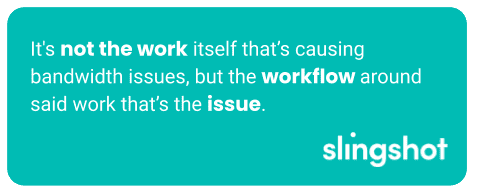As a tech leader, you’re constantly pulled in different directions, and your software team may feel the same way. Writing good code isn’t enough in our fast-paced world. You must be strategic and innovative while dealing with limited time and resources. So, how can you optimize your bandwidth?
Don’t worry, we’re here to help. In this article, we will discuss the factors that affect your operational bandwidth and how to fix them, focusing on software development teams and technical leadership.
Summary
This guide will help you identify operational bottlenecks and provide tips to improve productivity. It gives practical advice for optimizing workflows, communication, time management, and technology utilization. Whether you’re looking to empower teams, align strategies, or use automation, this blog covers you. It will help you navigate the digital landscape with ease and innovation.
Development Teams
Software teams face daily obstacles that slow them down and make their day less efficient. Recognizing these challenges is essential so everyone can work to tackle them head-on. After all, we all want to work smarter, not harder! You can ensure everyone performs at their full potential by identifying and eliminating bottlenecks.
Factors Affecting Operational Bandwidth
But what exactly are those bottlenecks? Great question: while it changes from one team to another, four factors impact almost any team’s bandwidth.
Workflow Bottlenecks
Developing software is great (we know we love it!) But sometimes, it can be a real pain; things get in the way and slow everything down. These include complex task dependencies, lack of process, poor communication, or resources being spread too thin. It’s not the work itself but the workflow around it that’s the issue. Simpler, focused, and well-resourced processes are just plain better!

Communication Challenges
Teamwork’s biggest hurdle is often communication issues. We also have access to more information now than ever, which means there’s too much of it sometimes. How do you know what’s essential and what’s just noise?
Plus, people tend to work on what they think they should be doing without clearly communicated expectations. Preventing communication issues requires frequent and consistent communication. It’s crucial to ensure everyone knows what they’re supposed to be doing and has a chance to share their ideas and ask questions.
Time Management
Everyone needs help managing their time and prioritizing tasks. Why? Priorities often change, tasks take longer, dependencies are complex, and developers may need a second opinion. To ensure effective work and timely delivery, software development teams must prioritize tasks, estimate time realistically, and monitor progress continuously.
Shifting Scope
It’s frustrating for development teams trying to solve an ever-evolving problem. And when new stuff gets added to software development projects without careful consideration, it can mess up the whole team’s workload. It’s called scope creep, leading to a domino effect of problems, like making tasks more complicated and communication harder.
To avoid the downsides of scope creep, try to communicate clearly and balance flexibility with sticking to the timeline. Being agile and using an iterative approach can help teams deal with changes in a way that doesn’t mess up their work.
Strategies for Enhancing Bandwidth
So we know what’s causing issues, but how do we fix them? To ensure that software development teams work efficiently, they must use strategies that make their tasks, communication, and processes better and more manageable.
Agile Methodologies
Agile methodologies can help your team in several ways. And we should know: Agile is what we use here at Slingshot! By breaking down tasks into smaller pieces, you can progress steadily and get feedback more often.
Plus, you’ll be able to easily pivot when necessary. With an Agile mindset, the team works sprint by sprint, deploying completed work as each sprint wraps up. Isn’t that the best use of your resources?
Effective Communication
Ensuring everyone is on the same page is super important; Daily Standups can help! They’re generally 15 minutes a day and provide an opportunity for each team member to share progress. Weekly Retrospectives give the team an open forum to chat about any challenges that need addressing. Using tools that help you collaborate, like messaging or screen-sharing apps, is also a good idea. Good communication helps everyone work better together.
Prioritization and Time Blocking
You should organize tasks based on importance and in the proper order for project work. To do that, you really need to have a feel for which features are most important and what dependencies exist. Your backlog of tasks should reflect this.
Also, give your team members time to ask questions and get clarifications before taking it on. Once all questions are answered, have them estimate the overall size of the task. You can use this to assess progress. For more fluid tasks, timebox them and let the team get the necessary answers.

Automate Repetitive Tasks
When you automate repetitive and boring tasks, you save a lot of time and brain space. Plus, you reduce the chance of human error. And, if you use automation tools and scripts, your team can focus on doing more important and challenging tasks, making the most out of their time and skills. Ultimately, it helps you optimize your workflow and get more things done. A great example of this in the software world is the deployment of changes. When developers finish an assigned task, they check in the code, triggering a deployment into the testing environment.
Managing Scope Change
Last-minute changes are a challenge that all development teams have encountered. It’s difficult to solve, but here are a few practical ways to manage it better. First, simple wireframes and prototypes allow others to visualize and iterate on a feature before committing to developing it. Communication is critical here, too. Once you have agreement on how the change will work, it’s essential to communicate the anticipated time and cost of the change. In addition, what will be the impact on other work? Stakeholders should be aware of the cost of change.
Tech Leadership
Tech leaders are doing so much more than just assigning tasks to people. You need to strategize, plan, and adapt. You need to be plugged into the ever-evolving tech world. You often have to negotiate with departments crying out for tech resources.
What is the best way to allocate your resources to work efficiently? Who from your team is best suited to take on the task? You’ll have to think hard about how to do things in the best way possible and ensure you’re applying your resources in a way that makes sense. Or… you could keep reading and learn how!
Factors Affecting Operational Bandwidth for Tech Leadership
As a tech leader, you’re expected to balance present needs with future goals. There’s a lot of information to sift through, and managing your time well is crucial in making the right decisions and keeping everyone on the same page.
Information Overload
It’s easy to get overwhelmed by too much information. When you have more and more to consider with each problem, your decision-making will come to a screeching halt. It can also lead to overthinking or needing more data to decide. You’ll want to filter information and focus on what’s important to make well-informed decisions.
Strategic Alignment
You want everyone to be on the same page regarding your company’s strategy. But, clashing priorities and team-centric mindsets can make a team meeting like a battlefield. Ensure that everyone understands the long-term strategy and that your short-term goals are aligned with it.
Needs vs Goals
Tech leaders have a tough job (but you already knew that!). You’re juggling multiple balls in the air, balancing what’s needed right now with what will happen. You gotta decide what resources should go towards dealing with immediate problems versus investing in future tech. You must ensure your team continuously learns and prepares for tomorrow’s demands. Striking a good balance means creating a plan that addresses short-term issues and sets you up for long-term success.
Strategies for Enhancing Operational Bandwidth in Tech Leadership
Good tech leaders are efficient in getting things done. Delegating tasks, filtering out unnecessary information, focusing on important things, and using technology to your advantage can get you there. Combined, these things will help you make better decisions and get things done faster.

Delegation and Empowerment
One surefire way to improve your bandwidth is to delegate responsibilities and empower your team. For instance, make the most of your resources by assigning tasks based on expertise. You can optimize resource utilization and avoid wasting time on tasks not a good match for your team. Additionally, empowering your team members can help them develop new skills and become more autonomous. All of this leads to smoother operations, which is always good.
Effective Decision-Making
It’s essential to filter and extract the most critical information when making decisions. What that means will change for each business and decision, so set up guidelines for what ‘relevant information’ means to you early. This helps you focus on the most critical pieces and avoid getting bogged down by irrelevant data. By doing this, you can make informed decisions quickly and avoid delays.
You should closely monitor critical metrics for each project, such as the budget-to-actual ratio and percentage of completion. It’s also important to keep an eye on the overall health of critical applications, including error rates and reviews. You should routinely assess the security posture of your area of responsibility, which may involve reviewing pen test results and security events. Additionally, staying up-to-date with significant events in your industry and the technology field is essential.
Prioritizing Key Initiatives
Using time management techniques and prioritization methods, you can make the most of your time and focus on what’s important. This means allocating your time between immediate tasks and strategic initiatives and prioritizing the key objectives that align with your long-term goals.
To effectively prioritize work, though, you must understand what’s happening around the organization. There may be a pressing need for a new feature, but you need to balance that with a recent security issue that was identified. Your team will also appreciate knowing why one initiative is prioritized over another.
Leveraging Technology
You’re a tech team, so use it! Automating tasks with technology can be the final ace up your sleeve. Save time and help yourself focus on more important things like making plans and developing new ideas. This way, they can make better decisions and utilize technology to get things done faster and better.
You know what’s possible with technology. Use that knowledge to help the organization leverage it effectively. Are there processes that are ripe for automation using machine learning? Do you have resources involved in the manual deployment of code? Can you use technology to scan your environments for security concerns continuously?
Conclusion
What a journey. We covered a lot: bottlenecks, scope creep, information overload, goal misalignment, agile, automation, delegating, prioritization, and so much more!
As you continue to have more and more pressure placed on you, either as a development team member or leading the charge, we hope you’re more equipped to roll with the punches, thanks to more bandwidth.
Want More Team Help?

Written by: Savannah
Savannah is our one-woman marketing department. She posts, writes, and creates all things Slingshot. While she may not be making software for you, she does have a minor in Computer Information Systems. We’d call her the opposite of a procrastinator: she can’t rest until all her work is done. She loves playing her switch and meal-prepping.

Edited by: Chris
Chris has been in the technology space for over 20 years, including being Slingshot’s CIO since 2017. He specializes in lean UX design, technology leadership, and new tech with a focus on AI. He’s currently involved in several AI-focused projects within Slingshot.




